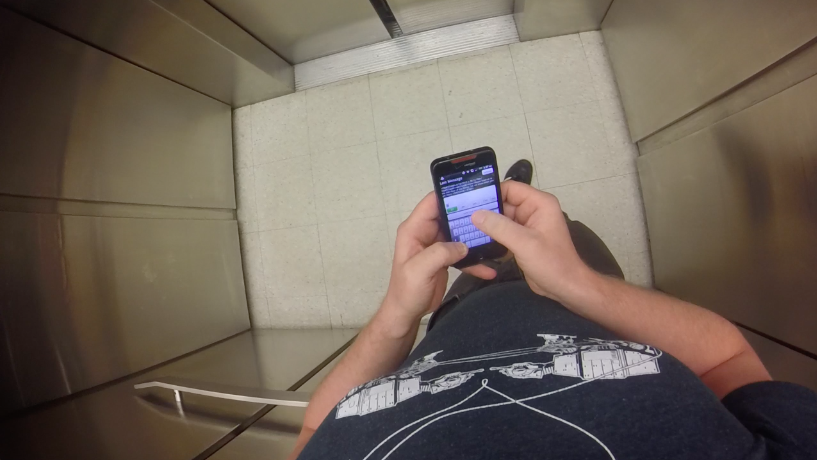Type, Delete, Repeat: Exploring How We Write for Mobile Devices

As you alternate between using a computer and a mobile device, your writing style likely changes.
Users must not only adapt to each writing instrument’s unique set of physical characteristics (i.e., a laptop keyboard versus a mobile touchscreen with autocorrect capability). They must also navigate the environmental and social norms that accompany the different technologies.

NC State graduate student Joel Schneier studies how we write for mobile devices — and how those practices affect our day-to-day communications. We caught up with Schneier about one of his recent studies, in which he compared editing and revising practices for mobile devices and computers.
Schneier, a doctoral candidate in the Communication, Rhetoric and Digital Media program, recently presented his work through a research poster at the 2018 NC State Graduate Student Research Symposium.
Q: What drew you to this research?
I’ve always studied and been fascinated by writing, particularly how people learn to write and transfer writing skills across different areas of their lives. While a lot of writing research focuses on students in a classroom learning to write for academic purposes, this misses out on how those same students write constantly throughout the day on their mobile phones. So part of my interest is in how people write on their phones for very social and meaningful purposes, whether it’s text messaging with their friends, posting on Reddit, emailing their employers, and so on. These are very different practices than writing an essay or lab report — even though you could use a mobile phone to write these.
Also, as I learned from my own experiences, writing on a mobile phone is physically different than writing on a typical computer keyboard. Even though both use the same traditional QWERTY keyboard layout, on a phone you can’t feel the touch of each key because the touchscreen flattens the keyboard. We not only have a smaller keyboard that we can’t touch-type on, but we also have more advanced assistive writing (such as autocorrect and autosuggest), speech-to-text input, emoji packages, swipe and so forth. Plus, since our phones are mobile, we can write from virtually anywhere and even while in transit.
In short, writing on mobile devices fascinates me because it is a new and unique social practice that involves different physical and technological input processes, and studying these practices through keystroke logging is a potential way of observing the choreography between these levels.
Q: What did you study?
My study looked very closely at keystroke-logging data from individuals writing on a mobile phone. A keystroke log file shows the time (in milliseconds) that each key from a keyboard is pressed. If you have a record of what key is pressed as well as when it is pressed, you can reconstruct the timeline of how a text was composed — including the time between writing (when you may be thinking about the next word you want to write, or reviewing what you have already written) and what individuals delete as part of editing or revision.
The study I reported on at the NC State Graduate Research Symposium looked closely at what text participants in the study deleted and revised, compared to keystroke data collected from an individual writing on a computer. Specifically, I was interested in how much text individuals deleted as well as what they wrote afterwards. Would participants delete an entire sentence to write a similar sentence with different phrasing? Would they delete several words to correct a single typo and then rewrite the same words? Would they only delete the word they had just written, and what would come in its place?
Q: How did you collect the keystroke data you analyzed?
While keystroke-logging analysis has been used in writing research for nearly three decades, it has yet to be applied to mobile writing. In what started as a project in a graduate seminar class here at NC State, a colleague (Peter Kudenov) and I conducted a small study to see what we could learn from using keystroke logging methods to study mobile writing, as we reported in “Texting in Motion: Keystroke Logging and Observing Synchronous Mobile Discourse,” published in Mobile Media & Communication.
In that study, we had participants use a smartphone with a custom-made chat application that Peter built to log keystrokes from the virtual keyboard. We sent messages to the phone to communicate instructions to the participants, and we had them write back to coordinate those instructions, which were small tasks around D.H. Hill Library (e.g., go the fifth floor, find this book, go to the learning commons, etc.). While they were following these instructions, we also asked them questions (through the phone) about their own mobile phone usage and perceptions about writing, and they were expected to answer these questions through the chat application.
While seemingly trivial, the distinction between these kinds of deletion and revision patterns may hint at significant differences in the ways we write on these different devices.”
— Joel Schneier
In total, we collected 2,056 keystrokes, and we observed that different keystroke patterns appeared to coordinate with the different tasks and physical process of walking about the library. For example, participants typed at a slower rate and revised more when answering more personal questions, which may suggest more deliberative and careful writing; however, they typed at a faster rate and revised less when responding to the more task-oriented messages, which may suggest less attention is paid to these sort of messages.
The study I reported on at the Graduate Research Symposium looked more closely at this keystroke data, and compared it to keystroke data collected from a participant writing an academic paper on a computer. (This was data from a separate study, used with the participant’s permission.) Since the mobile and computer keystroke data were gathered from different studies and involved individuals writing in very different contexts and for different purposes, I am by no means suggesting that these are equal to one another. Rather, I used these data as a way to explore possible differences in the timing patterns of composing a text (whatever that text may be) key-by-key.

Q: What did you find?
For the most part, deletion and revision patterns across the mobile and computer keystroke data saw similar frequencies. However, mobile keystroke data showed that individuals were much more likely to delete an entire word, and then rewrite the exact same word. This was typically done to edit a typo in the word.
Speaking of typos, I found that typically when participants appeared to delete only specific characters in a word that these appeared to be for very different kinds of typos. On a mobile device, the typos typically involved pressing a key that was next to the intended key. This was not the case for typos from the computer keystroke data, although it appeared that typos were frequently due to a mismatch between keys typically pressed with different hands.
While seemingly trivial, the distinction between these kinds of deletion and revision patterns may hint at significant differences in the ways we write on these different devices. In order to examine this further, I looked at the timing between deletions and revisions. I did this by examining the duration of time (in milliseconds) between when a participant pressed the last backspace key and when they pressed the first key in the revision text. After deleting text, participants writing on mobile phones paused for typically more than 500 ms (over half a second), whereas the participant writing on a computer typically paused for under 500 ms. Furthermore, the more content that the mobile writers appeared to have deleted, the longer they paused.
Q: What might your findings suggest for mobile writing processes?
Even though this difference is in milliseconds and only barely noticeable to the human eye, the distinction in pauses does suggest that writing on a mobile phone may involve different cognitive and physical demands than writing on a computer. Because the keyboard is smaller and you can’t physically feel the keys, you may need to spend more time looking at your fingers as you press down, a process that makes reviewing and revising more demanding because you have to look back and forth. On a computer, you can let your fingers do the work of finding and pressing the right key while your eyes are free to read what you write as you write it, which can make it less demanding to revise content.
The consequences of this distinction may not be noticeable or even that important for many of the writing tasks we currently do on mobile phones. It’s also likely that these distinctions say as much about the social purposes and contexts of composing text messages, Snapchats, Instagram posts, etc., all of which can accomplish different goals through different revision processes. But as more and more kinds of writing are done through mobile phones for very different purposes,understanding more about the cognitive and physical demands of mobile writing can help us design improved strategies (and maybe even software) to prepare people to write effectively regardless of what device they use.
Of course, this is one small study. Being able to further understand how people write on mobile phones based on keystrokes really requires more research with many more participants and consideration of people who write on mobile phones in many different ways. In fact, I am currently conducting a new study that studies how people write on their phones over the course of an entire week, and I’m really hoping that study will yield richer results. This study requires participants to download and use a virtual keyboard application for Android devices, and anyone who is interesting in participating can contact me at jischnei@ncsu.edu.


